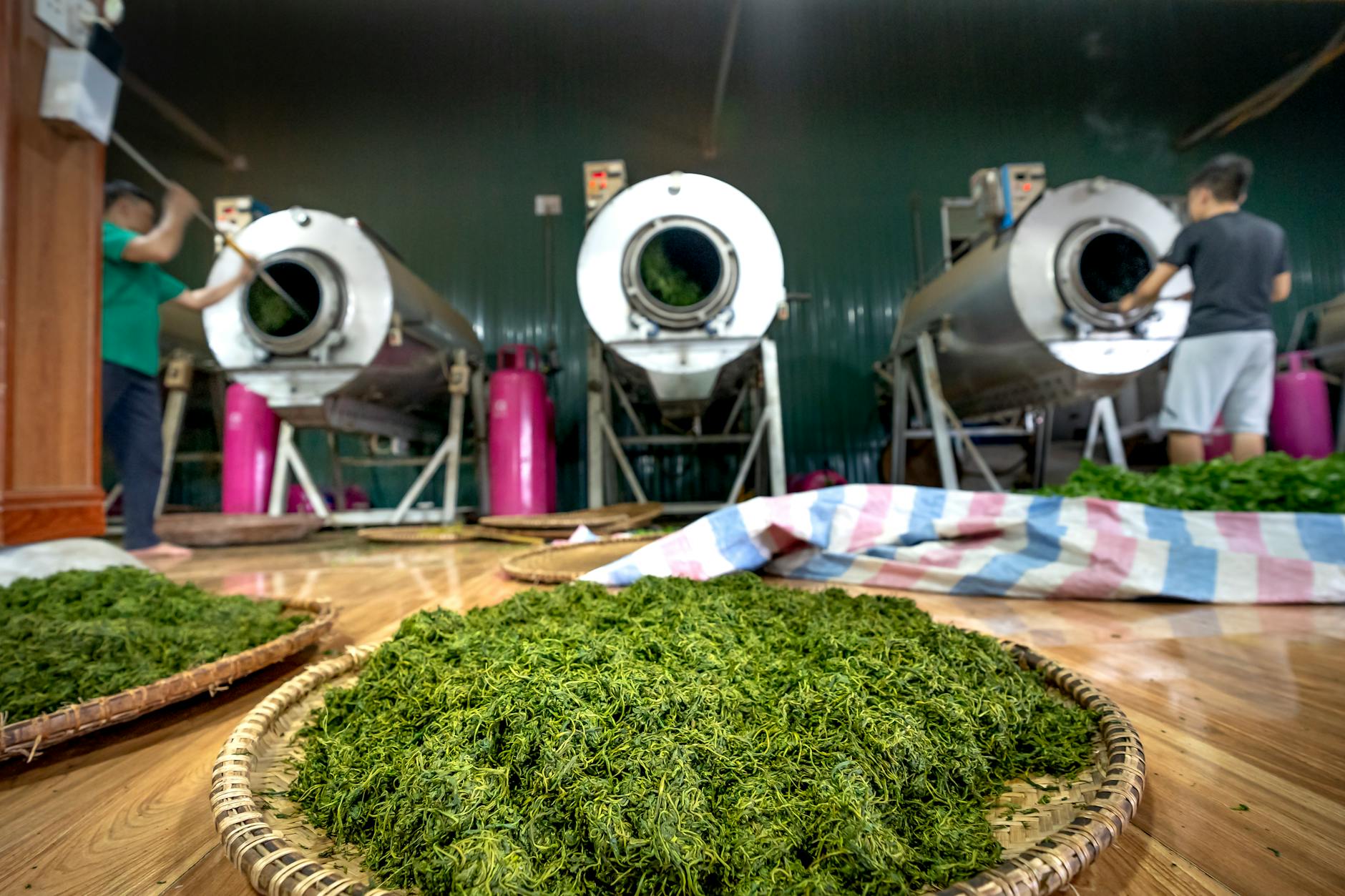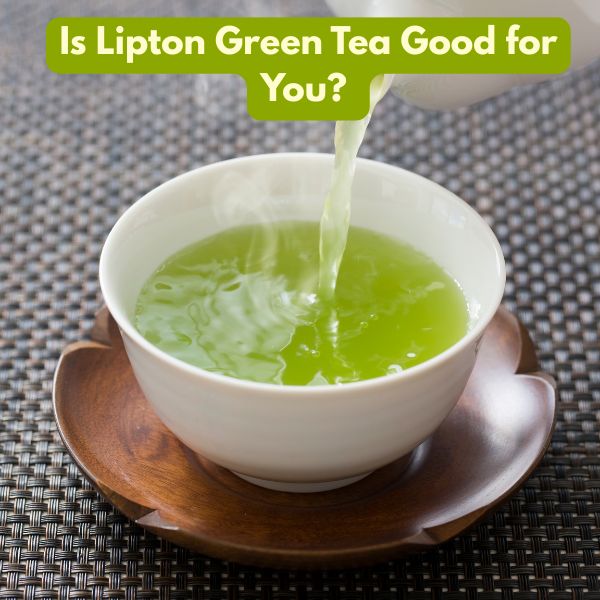Health Benefits, Risks, and Easy Ways to Enjoy It
If you’ve ever wondered, “is Lipton green tea good for you?”—you’re not alone.
This tea’s popularity keeps rising, thanks to a steady buzz about green tea and wellness.
People love it for its light taste, easy brewing, and the idea that each cup supports a healthier lifestyle.
Lipton Green Tea stands out because it’s packed with natural flavonoids, which are known to support heart health and help protect your cells.
Fans say it can even offer a gentle metabolic lift—especially when paired with smart habits like Tea Burn (find out more here).
Like all green teas, it fits right in if you’re trying to eat better or cut sugary drinks from your day.
It’s easy to get creative with Lipton Green Tea, too. Squeeze in fresh lemon, add a splash of honey, or chill it with mint for a refreshing twist.
If you care about what you drink, Lipton gives you an easy, approachable way to make green tea part of your healthy routine.
In this post, you’ll see the perks, the possible risks, and how to get the most from every cup.
What’s Inside Lipton Green Tea?
Ingredients, Nutritional Profile, and Production
When you’re thinking, “is Lipton green tea good for you?” it helps to know exactly what’s in your cup. The answer isn’t just about flavor—it’s about where the tea comes from, what it brings to the table nutritionally, and how it’s processed.
Let’s look at the details that make Lipton Green Tea a popular pick for anyone looking for a simple, refreshing boost to their daily routine.

Photo by Quang Nguyen Vinh
Core Ingredients in Lipton Green Tea
Lipton Green Tea keeps things simple and lets the natural tea flavor shine. Here’s what you’ll typically find in a classic cup or bag:
- Green tea leaves (the star of the show)
- Water (when brewed, of course)
- Optional extras in flavored or bottled versions—like lemon, honey, or natural citrus flavoring
If you prefer bottled options, check the label. Some bottled Lipton green teas may include:
- Natural flavors
- Citric acid to add tang and keep things fresh
- Ascorbic acid (Vitamin C) for added nutrition
- A modest amount of sugar or sweeteners in some varieties
For example, if you check out the Lipton Green Citrus ingredient list, you’ll notice a mix of filtered water, green tea, sugar, citric acid, and Vitamin C.
Every ingredient has a reason: taste, freshness, or nutritional perks.
Nutritional Profile: What Does a Cup Offer?
Lipton Green Tea’s nutrition story is refreshingly straightforward, especially in its pure, unsweetened form.
Here’s what you can typically expect per serving (based on plain brewed tea):
- Zero calories (unless you add sugar or honey)
- No fat or cholesterol
- No sodium
- Modest caffeine—usually between 20-30 mg per cup (that’s less than coffee)
- Polyphenols and flavonoids, powerful antioxidants that support your cells and heart
- Trace minerals like manganese
If you’re aiming for a healthy lifestyle, this is good news. Green tea offers a way to hydrate that doesn’t rely on added sugar or artificial ingredients.
And if you’re exploring metabolism-boosting options, green tea fits right in with products like Tea Burn.
Bottled and flavored versions are a little different:
- Nutritional values may change with added sugars or flavors.
- Vitamin C is often added for a little extra immune support.
- Check the nutrition label to compare varieties and choose what fits your goals.
How Lipton Green Tea Is Made: The Production Journey
The magic of green tea starts before the water even boils.
Quality tea depends on how it’s grown, picked, and processed—each step shapes the final taste and benefits.
- Careful cultivation
Tea plants flourish in warm, humid climates. They’re usually grown on large estates and cared for so the leaves stay tender and full of natural goodness. - Harvesting at the right moment
Only the youngest leaves and buds are picked—often by hand. This preserves the delicate flavor and nutrients. - Minimal processing
Once harvested, the green tea production process is all about keeping things natural:- The leaves are steamed or pan-fired quickly to prevent oxidation (the process that turns tea black).
- After heating, the leaves are rolled and dried, locking in their bright green color and mild taste.
- Quality checks
Throughout the journey, Lipton checks for freshness, flavor, and consistency.
This balance of traditional technique and modern quality standards helps Lipton deliver green tea that’s tasty, accessible, and true to its roots.

Fun Ways to Upgrade Your Lipton Green Tea
Plain green tea is perfect for purists, but you can get creative if you like. Here are simple ways to make your cup unique:
- Add a wedge of lemon or orange for a citrusy twist.
- Sprinkle in fresh mint or basil for an herbal lift.
- Stir in a drizzle of honey for natural sweetness.
- Chill and serve over ice for a refreshing summer drink.
- Mix with a scoop of Tea Burn if you’re interested in a metabolism-friendly boost.
Explore these ideas to keep every cup new and interesting.
With the right tweaks, Lipton Green Tea can fit almost any flavor mood or wellness goal.
If you’re looking to go beyond the basics, try some creative tea recipes shared by Lipton for more inspiration.
Is Lipton Green Tea Good for You?
Scientific Evidence and Health Benefits
When you pour a cup of Lipton Green Tea, you might wonder what science has to say about its perks.
Is Lipton green tea good for you beyond just being tasty and refreshing?
Let’s break down the current research and see how your daily brew can fit right into a heart-friendly, vibrant routine.
Cardiovascular and Metabolic Benefits of Green Tea
 Photo by Alex P
Photo by Alex P
Green tea has long been celebrated for its potential to support heart health.
Drinking Lipton Green Tea regularly, especially in the usual 8-ounce serving, provides a natural source of plant compounds that help your body in several ways.
Here’s what research says about green tea and your cardiovascular system:
- Cholesterol levels: Studies show that green tea can help lower LDL (“bad”) cholesterol. The flavonoids found in Lipton Green Tea are key players here.
- Blood pressure: Regular green tea drinkers often see mild reductions in blood pressure, which matters for keeping your heart strong.
- Stroke risk: Some research suggests a link between green tea consumption and reduced risk of stroke. This effect seems to build up the more you make tea a habit.
- Weight management: If you’re watching your waistline, green tea might offer a small edge. There’s steady evidence for modest weight loss with frequent intake, especially when paired with an active lifestyle or products like Tea Burn.
- Metabolic effects: Drinking green tea may support healthy blood sugar and metabolism. This benefit is most noticeable among those who make it a daily part of their routine.
Most clinical studies focus on servings of 2–3 cups a day—the sweet spot for both enjoying the taste and reaping the rewards.
For more detail, you can explore the top 10 evidence-based benefits of green tea.
Antioxidant Protection and Cellular Health
What sets green tea apart from black tea or coffee? It’s all about antioxidants, and Lipton Green Tea serves up some of nature’s best.
The star compounds are catechins and a powerful molecule called EGCG (epigallocatechin gallate).
These antioxidants:
- Help neutralize harmful free radicals, reducing daily oxidative stress.
- Support your body’s fight against inflammation, which matters for everything from heart health to how you age.
- May slow signs of aging in skin by supporting cell repair and resilience.
Drinking Lipton’s green tea isn’t just soothing—it actually helps protect your cells from everyday wear and tear. Health researchers have seen these antioxidants lower markers of cell damage, especially when sipping tea becomes a regular ritual.
Want to dig deeper into the science?
Take a look at these published reviews on green tea’s antioxidant effects and how tea polyphenols affect your cells.
As a small bonus, adding a squeeze of lemon to your Lipton Green Tea may actually help your body absorb more of these helpful catechins.
Try flavor twists with ginger, berries, or a splash of honey to boost both taste and benefits.
Cognitive Function and Mental Well-Being
A warm cup of Lipton Green Tea isn’t just soothing for your body—it’s gentle on your mind too.
The unique combination of caffeine (much less than coffee) and an amino acid called L-theanine is thought to create a smooth, alert feeling without the crash you get from other caffeinated drinks.
Here’s what research highlights about green tea and your brain:
- Cognition and memory: Some studies show that regular green tea drinkers perform a bit better on memory and attention tasks. It’s like a nudge for clearer thinking, without feeling jittery.
- Stress management: The L-theanine in green tea helps take the “edge” off and adds a sense of calm, even as the caffeine gives focus.
- Neuroprotection: There’s early evidence that the antioxidants in green tea, especially EGCG, help shield nerve cells from stress and may support long-term brain health.
It’s not about instant breakthroughs, but about giving your mind steady support with every cup.
If you sometimes feel scattered or just want a better midday lift, replacing a sugar bomb soda with Lipton Green Tea is a smart move.
Fans who want an extra cognitive spark sometimes combine their tea drinking with products like Tea Burn, which are designed to complement focus and energy.
If you have an afternoon slump or want to stay sharp through study sessions, keeping a mug of Lipton Green Tea nearby may be your new secret weapon.
Studies covered by Harvard’s School of Public Health show that making tea a routine part of your day—not just a treat—brings better results.
Enjoy your next cup knowing it’s not just a tasty tradition, but a science-backed choice for body and mind.
Potential Side Effects, Safety Concerns, and Who Should Be Cautious
Before you reach for another cup of Lipton Green Tea, it’s smart to know about possible side effects and when a little caution may be wise.
For most people, green tea is a gentle, everyday drink. But as with anything, there can be a few bumps in the road—especially if you sip a lot or have certain health issues.
Let’s cover what you should watch for, and who might want to take it slow.
Potential Side Effects of Lipton Green Tea
Lipton Green Tea is usually well-tolerated, but drinking too much or being sensitive to some ingredients can bring mild issues.
Here’s what to keep in mind:
- Caffeine effects: While Lipton Green Tea has less caffeine than coffee, some folks feel shaky, jittery, or get headaches after a few cups. Caffeine can also bump up your heart rate and make it tough to sleep if you drink it late in the day.
- Stomach upset: Too much green tea, especially on an empty stomach, might lead to nausea or a slightly upset tummy. This is more likely if you’re sensitive to caffeine or tannins.
- Iron absorption: Tea contains natural compounds that can slow down iron absorption. If you’re at risk for low iron, try drinking your tea between meals rather than with food.
- Rare reactions: According to WebMD and Medical News Today, some people report mild anxiety, irritability, or a racing heartbeat after several cups. These symptoms fade if you cut back or switch to decaf.
For most healthy adults, moderation is key.
A cup or two is unlikely to cause problems and brings plenty of perks.
Safety Concerns: What Should You Know?
Green tea is largely safe when enjoyed as a regular beverage. Problems tend to pop up when people overdo it on super-strong extracts or take in large amounts daily.
Let’s make it simple:
- Too much caffeine: Loading up on green tea can add up to 200 mg of caffeine or more per day if you drink many cups. For most adults, up to 400 mg from all sources is safe, but everyone’s “just right” is different.
- Sensitive stomach: If tea makes you queasy, try eating first or switching to a lighter brew.
- Supplements vs. tea bags: The risks rise with concentrated green tea powders or “fat burner” products, which may upset your liver or stomach if misused. Always follow labels and start slow.
- Mixing with medicines: Green tea can interact with certain medications, including blood thinners and some heart drugs. If you take prescriptions, talk to your doctor to be on the safe side.
For a more in-depth review, the NCCIH notes that drinking green tea as a beverage is usually safe, but extracts and high doses require more caution.

Who Should Be Cautious With Lipton Green Tea?
Some people should take extra care with green tea—even if they’re big fans.
Here are groups who might want to limit intake or check with a healthcare pro first:
- Pregnant or nursing women: Green tea is usually fine in small amounts, but high caffeine can cross to baby or affect milk. One or two cups per day is typically considered safe—always check with your doctor.
- People with anemia: Because tea can curb how well your body soaks up iron from food, those with existing low iron should avoid tea with meals.
- Young children: Most kids don’t need extra caffeine, so save the green tea for grownups. The occasional light brew is not risky, but moderation wins.
- People sensitive to caffeine: If coffee keeps you up or triggers anxiety, green tea might, too. Try decaf or switch to herbal options on tough days.
- Anyone with heart conditions: Even modest caffeine can impact blood pressure or heartbeat. If you have a diagnosed heart concern, ask your care provider how much is safe for you. As Harlem World Magazine highlights, people with preexisting heart problems should approach green tea with a little more care.
If you add wellness blends or boosters like Tea Burn to your routine, read ingredient lists and start slow to see how your body reacts.
Quick Tips for Safe Sipping
To get the most out of Lipton Green Tea without worry:
- Enjoy 1–3 cups daily, and drink between meals to help your body use iron from food.
- Skip extra cups after lunch if you’re sensitive to caffeine or want better sleep.
- Add lemon, honey, or fresh herbs to switch up flavors without adding much risk.
- If you use Tea Burn for its metabolism and energy perks, follow the serving suggestions on the package and don’t combine with high-caffeine drinks.
Lipton Green Tea is a friendly choice for most—but a little bit of attention to how your body feels will keep your tea ritual as easygoing as it should be.
Ways to Enjoy Lipton Green Tea:
Recipes, Enhancements, and Tea Burn
Lipton Green Tea offers more than just a simple, soothing cup.
Whether you’re seeking a moment of calm, a wellness boost, or a cool drink on a summer day, there are many ways to enjoy and upgrade your experience.
If you’re still asking yourself, “is Lipton green tea good for you?”—let’s look at tasty, creative ways you can adapt every cup to suit your taste and goals.
Creative Recipes for Lipton Green Tea
Stepping outside the basic brew is a fun way to keep your green tea routine exciting. Here are a few simple ideas that you can try at home:
- Classic Hot Brew
Steep Lipton Green Tea in hot (not boiling) water for 2–3 minutes. Add a slice of lemon or a drizzle of honey for a gentle lift. - Refreshing Iced Green Tea
Brew as usual, let cool, and pour over ice. Toss in fresh mint or a few cucumber slices for a spa-like twist. - Green Tea Smoothie
Blend cooled green tea with a banana, a handful of spinach, and frozen berries. This turns your daily tea into a morning super-drink. - Herbal Infusion
Add chopped ginger or a sprig of rosemary to your mug before pouring hot water over the tea bag. - Fruit-Infused Tea
Pop a few peach or mango slices in while the tea steeps for a naturally sweet and fruity flavor.
If you want even more variety, Lipton shares a helpful collection of green tea recipes and inspiration you can use for gatherings or just to mix things up.
 Photo by Ryutaro Tsukata
Photo by Ryutaro Tsukata
Simple Enhancements for Your Green Tea
There’s no need to keep your green tea routine boring. A few small tweaks turn even a basic mug into a mini celebration.
Try these tricks:
- Add citrus: Fresh lemon, lime, or orange not only adds zing but can also help you absorb more antioxidants from your tea.
- A touch of honey or agave: Sweeten your tea without refined sugar. Start small—you might be surprised at how much flavor a drop or two adds.
- Fresh herbs: Mint, basil, or a hint of thyme give a fresh, herbal aroma.
- Cold steeping: Pop your tea bag in cold water and chill for several hours. This makes a milder, naturally sweeter tea and is great for those sensitive to bitterness. For tips, see what tea lovers recommend on Reddit’s tea community.
Mix and match these extras to suit your mood or the season.
That’s the beauty of keeping Lipton Green Tea on hand—it’s a blank canvas you can shape any way you like.
Boosting Your Brew with Tea Burn
If you’re looking for an extra kick from your daily cup, many people now add Tea Burn to their routine.
This supplement is designed to blend seamlessly with hot drinks, giving your green tea an extra nudge for metabolism and energy. Why is this a popular option?
- Easy to use: Just add a scoop of Tea Burn to your cup—no extra steps or fuss.
- Metabolism perks: The ingredients are crafted to work alongside the natural benefits of green tea, aiming to support calorie burn and help you feel your best.
- Flavor neutral: Unlike some mix-ins, Tea Burn doesn’t overpower your favorite enhancements or green tea flavor.
You don’t have to stick with just tea and water.
Go ahead and experiment! Many people blend their green tea with Tea Burn, a hint of citrus, or a slice of ginger—making each mug a mini wellness ritual tailored to their needs.
For more on how green tea can support fat burning, read about the evidence-based benefits of green tea. As always, listen to your body and enjoy your tea in the way that makes you feel good.
By mixing up your recipes or adding a little Tea Burn, Lipton Green Tea becomes much more than just a plain brew.
With every cup, you can adjust flavors, add function, and make sipping green tea a fresh part of your day.
Conclusion
Lipton Green Tea can easily earn a spot in most healthy routines.
It offers reliable benefits, from antioxidant support to gentle metabolism perks, and fits well for those aiming to lighten up their beverage choices.
The natural flavonoids and modest caffeine levels make each cup both refreshing and purposeful.
Simple tweaks—like a squeeze of lemon, a touch of honey, or even a boost from Tea Burn—can make the experience tastier and tailor the brew to your needs.
Unsweetened options are best for health, while flavored or bottled versions should be enjoyed mindfully due to added sugars.
Is Lipton green tea good for you? For most people, yes—especially with balance and a little creativity.
Thanks for reading—share your favorite recipe twist or tea tip in the comments, and let’s keep making every cup count.






